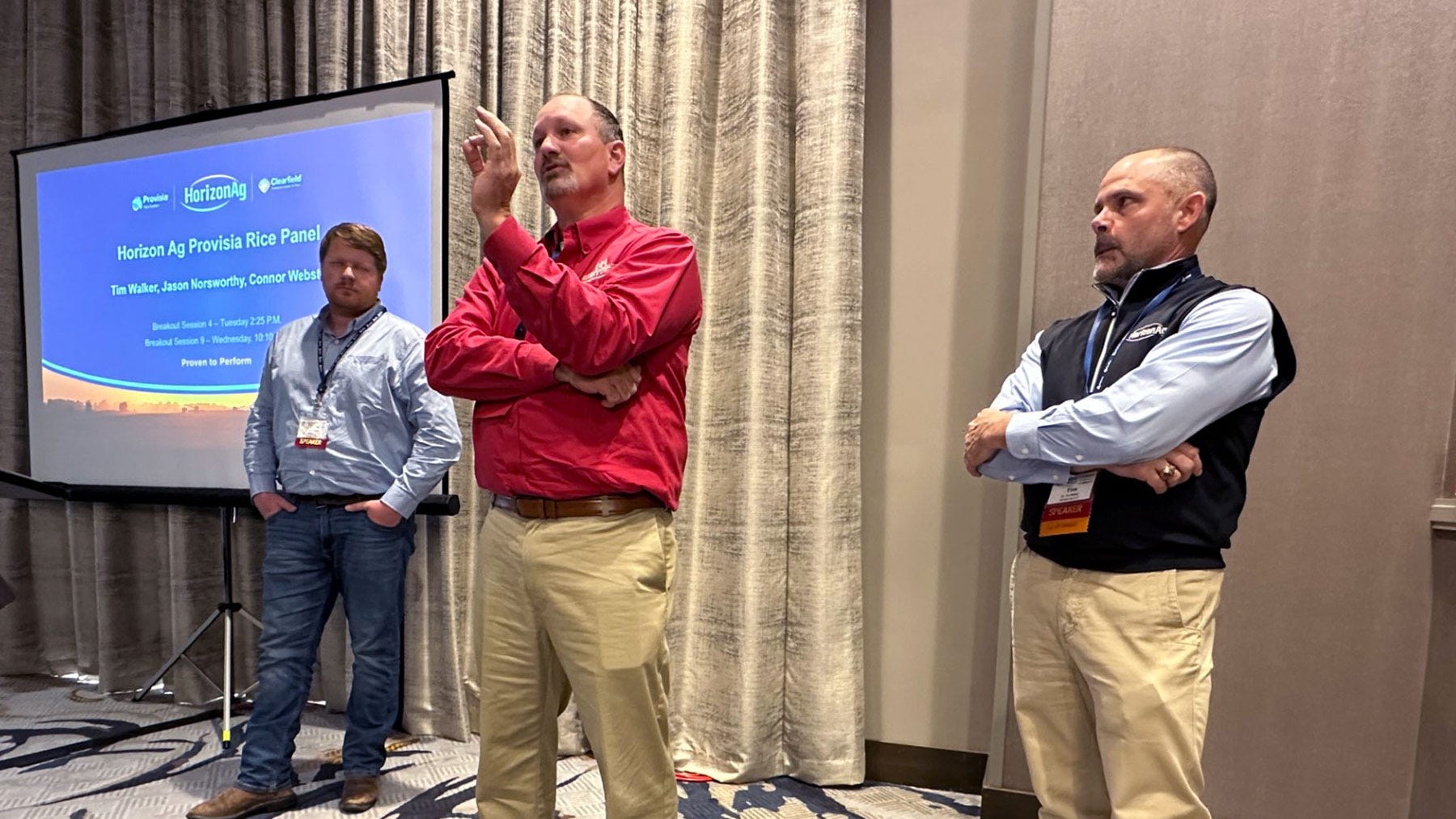
Carefully plan crop rotation
Herbicide-resistant weedy rice significantly impacts yield potential, and the pressure intensifies in problem fields placed in continuous rice rotations. With limited technology to combat weedy rice, many farmers turn to Acetyl-CoA carboxylase (ACCase) chemistries, like the Max-Ace Cropping Solution or Provisia Rice System, as their only options.
However, weed scientists and industry experts warn of the importance of stewardship to preserve the ACCase technology and the longevity of the chemistry, because it is the only method of protection against weedy rice on the market for the foreseeable future.
Once weedy rice populations outcross into these ACCase systems, herbicide resistance sets in, and the efficacy of the technology is lost. Best management practices are key, and sometimes drastic measures are necessary to get weedy rice populations under control.
This winter, industry and university experts from across the Midsouth rice belt participated in panel discussions at the National Conservation Systems Cotton and Rice Conference in Jonesboro, Ark. to share their advice on rice production with the Max-Ace and Provisia systems.

During the 2024 National Conservation Systems Cotton and Rice Conference, the Horizon Ag Provisia Panel discussed the importance of stewarding the ACCase inhibiting herbicide technology in rice production systems. Photo by Whitney Haigwood
Crop rotation as a solution
- Before ACCase rice cropping systems, the best option for farmers to control weedy rice was an imidazolinone (IMI) herbicide system like Clearfield or FullPage rice. In the last several years, these chemistries began to fail with weedy rice populations resistant to the IMI technology.
- In these cases, farmers were left with one option, ACCase technology, for weedy rice control. Then in 2022, reports came from Louisiana and south Arkansas of cross resistance to both IMI and ACCase herbicides in weedy rice.
- For fields with heavy weedy rice populations, chemistry selection is critical and consecutive years of rice rotations with the same chemistry should be avoided. Furthermore, heavy weedy rice populations decrease the efficacy of the IMI and ACCase chemistries and increase the chance of herbicide resistance.
- This resistance occurs when resistant weedy rice matures to seed and outcrosses into the rice crop. When that happens, drastic measures are necessary to control it. In these situations of herbicide failure, a farmer’s best line of defense is cropping rotation.
- The big takeaway: “If you are in a situation with heavy weedy rice infestation across the field, you do not want to go with a Max-Ace or Provisia. We have to break the cycle, and the best way to do that is with a different rotation,” said ADAMA Product Development Manager Jason Meier.
Importance of starting clean
- Regardless of the rice system you choose, start the season off right with a clean field. Meier said do whatever it takes to get a good burndown program up front, whether it is a late fall application or early spring application, so you have residual weed control at planting to kill grasses. Otherwise, you will be chasing grass all season long.
- Keep in mind that while ACCase herbicides do work to combat grasses, it is not best practice to solely rely on the chemistry for grass control. Instead, overlap residuals to control grass and devote the ACCase herbicide to weedy rice.
- Tim Walker, general manager at Horizon Ag emphasized the importance of utilizing residuals. He said, “We have one bullet to kill weedy rice and that is the ACCase herbicide. Do not forget about all these other bullets we have for grasses. We need to make sure we are giving the ACCase herbicide the best opportunity to kill the weedy rice and not just using it as a one size fits all weed control program.”
- Meier recommends a good pre-emerge system like Valor early preplant, Command plus glyphosate and Sharpen at planting, or tillage to start the season strong. For those who cannot get in a timely preemergent application Meier suggests a delayed preemergence application of a Prowl and Bolero mix.
- For Arkansas farmers, Norsworthy recommends using clomazone to get ahead of barnyardgrass and other grasses. Other residual herbicide options include Quinstar(quin
SDGs, Targets, and Indicators
SDGs Targets Indicators SDG 2: Zero Hunger Target 2.4: By 2030, ensure sustainable food production systems and implement resilient agricultural practices that increase productivity and production, that help maintain ecosystems, that strengthen capacity for adaptation to climate change, extreme weather, drought, flooding and other disasters, and that progressively improve land and soil quality. – Yield potential of rice crops
– Efficacy of herbicide technologiesSDG 15: Life on Land Target 15.1: By 2020, ensure the conservation, restoration and sustainable use of terrestrial and inland freshwater ecosystems and their services, in particular forests, wetlands, mountains and drylands, in line with obligations under international agreements. – Impact of weedy rice on yield potential
– Importance of stewardship to preserve ACCase technology1. Which SDGs are addressed or connected to the issues highlighted in the article?
The issues highlighted in the article are connected to SDG 2: Zero Hunger and SDG 15: Life on Land.
2. What specific targets under those SDGs can be identified based on the article’s content?
Based on the article’s content, the specific targets that can be identified are Target 2.4 under SDG 2 and Target 15.1 under SDG 15.
3. Are there any indicators mentioned or implied in the article that can be used to measure progress towards the identified targets?
Yes, there are indicators mentioned in the article that can be used to measure progress towards the identified targets. These indicators include the yield potential of rice crops, the efficacy of herbicide technologies, the impact of weedy rice on yield potential, and the importance of stewardship to preserve ACCase technology.
SDGs, Targets, and Indicators
SDGs Targets Indicators SDG 2: Zero Hunger Target 2.4: By 2030, ensure sustainable food production systems and implement resilient agricultural practices that increase productivity and production, that help maintain ecosystems, that strengthen capacity for adaptation to climate change, extreme weather, drought, flooding and other disasters, and that progressively improve land and soil quality. – Yield potential of rice crops
– Efficacy of herbicide technologiesSDG 15: Life on Land Target 15.1: By 2020, ensure the conservation, restoration and sustainable use of terrestrial and inland freshwater ecosystems and their services, in particular forests, wetlands, mountains and drylands, in line with obligations under international agreements. – Impact of weedy rice on yield potential
– Importance of stewardship to preserve ACCase technologyBehold! This splendid article springs forth from the wellspring of knowledge, shaped by a wondrous proprietary AI technology that delved into a vast ocean of data, illuminating the path towards the Sustainable Development Goals. Remember that all rights are reserved by SDG Investors LLC, empowering us to champion progress together.
Source: farmprogress.com

Join us, as fellow seekers of change, on a transformative journey at https://sdgtalks.ai/welcome, where you can become a member and actively contribute to shaping a brighter future.





